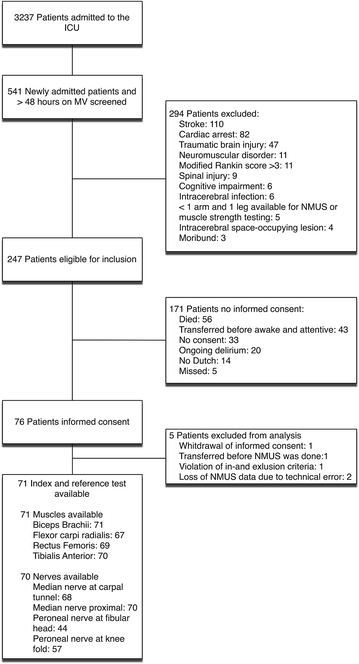Diagnostic accuracy of quantitative neuromuscular ultrasound for the diagnosis of intensive care unit-acquired weakness: a cross-sectional observational study
- PMID: 28382599
- PMCID: PMC5382120
- DOI: 10.1186/s13613-017-0263-8
Diagnostic accuracy of quantitative neuromuscular ultrasound for the diagnosis of intensive care unit-acquired weakness: a cross-sectional observational study
Abstract
Background: Neuromuscular ultrasound is a noninvasive investigation, which can be easily performed at the bedside on the ICU. A reduction in muscle thickness and increase in echo intensity over time have been described in ICU patients, but the relation to ICU-acquired weakness (ICU-AW) is unknown. We hypothesized that quantitative assessment of muscle and nerve parameters with ultrasound can differentiate between patients with and without ICU-AW. The aim of this cross-sectional study was to investigate the diagnostic accuracy of neuromuscular ultrasound for diagnosing ICU-AW.
Methods: Newly admitted ICU patients, mechanically ventilated for at least 48 h, were included. As soon as patients were awake and attentive, an ultrasound was made of four muscles and two nerves (index test) and ICU-AW was evaluated using muscle strength testing (reference standard; ICU-AW defined as mean Medical Research Council score <4). Diagnostic accuracy of muscle thickness, echo intensity and homogeneity (echo intensity standard deviation) as well as nerve cross-sectional area, thickness and vascularization were evaluated with the area under the curve of the receiver operating characteristic curve (ROC-AUC). We also evaluated diagnostic accuracy of z-scores of muscle thickness, echo intensity and echo intensity standard deviation.
Results: Seventy-one patients were evaluated of whom 41 had ICU-AW. Ultrasound was done at a median of 7 days after admission in patients without ICU-AW and 9 days in patients with ICU-AW. Diagnostic accuracy of all muscle and nerve parameters was low. ROC-AUC ranged from 51.3 to 68.0% for muscle parameters and from 51.0 to 66.7% for nerve parameters.
Conclusion: Neuromuscular ultrasound does not discriminate between patients with and without ICU-AW at the time the patient awakens and is therefore not able to reliably diagnose ICU-AW in ICU patients relatively early in the disease course.
Keywords: Critical illness myopathy; Critical illness neuromyopathy; Critical illness polyneuropathy; Diagnosis; ICU-AW; Neuromuscular ultrasound.
Figures
References
LinkOut - more resources
Full Text Sources
Other Literature Sources
Research Materials


